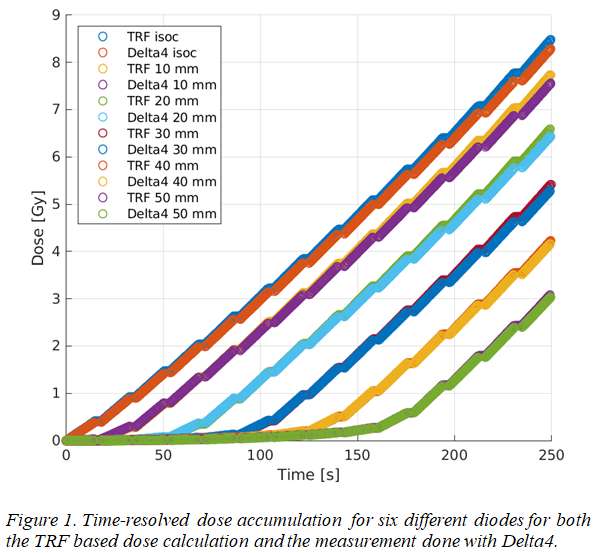Towards validation of treatment record file as an input for time-resolved dosimetry
Stijn Oolbekkink,
The Netherlands
PO-1557
Abstract
Towards validation of treatment record file as an input for time-resolved dosimetry
Authors: Stijn Oolbekkink1, Wilfred de Vries1, Bram van Asselen1, Jochem Wolthaus1, Simon Woodings1, Madelon van den Dobbelsteen1, Sara Hackett1, Arian van Appeldoorn1, Peter Münger2, Görgen Nilsson2, Bas Raaymakers1
1University Medical Center Utrecht, Radiotherapy, Utrecht, The Netherlands; 2ScandiDos, AB, Uppsala, Sweden
Show Affiliations
Hide Affiliations
Purpose or Objective
Currently, the Unity 1.5T MR-Linac (Elekta AB,
Stockholm, SE) (MRL) plans are adapted daily while the patient is lying on the
table. In an ideal world, real-time intra-fraction adaptations are desired. This future goal might be feasible with the MRL. For real-time adaptations
real-time feedback is needed. This can be done using data of the treatment
record file (TRF) of the MRL. In this file various parameters such as multi
leaf collimator (MLC) positions, dose and dose rate can be found with a sample
rate of 40 ms. The aim of this study is to demonstrate the validity of the TRF
files as an input for time-resolved dosimetry and the possibility to use it for
real-time quality assurance.
Material and Methods
Dose calculations with the TRF files as input for the GPU Monte Carlo dose (GPUMCD) algorithm, were performed for various field sizes from 1x1 cm² to 22x22 cm². The fields were delivered at a gantry angle of 45 degrees with 100 MU per field. The dose, gantry angle and MLC positions found in the TRF log file are used as input for the GPUMCD algorithm which can be used to calculate 3D dose distributions on Unity MRL.
To measure the delivered fields, the Delta4+ MR QA system (ScandiDos AB, Uppsala,
SE) was used in combination with a research version of the software to obtain
time-resolved dose data at intervals of 25 ms. The central region of 6x6 cm² has the diodes spaced 5 mm with 10 mm
elsewhere.
Results
The measured and calculated doses for all 14 fields are shown in figure 1, sequential from small to large as a function of time. The dose at different diode positions are illustrated for the diode located at isocenter (isoc) and the diodes at 10, 20, 30, 40 and 50 mm away from isoc in the left-right plane respectively. For each TRF time stamp the corresponding dose is calculated for each diode position found in the Delta4 measurement. It is clearly visible that with increasing time the delivered dose becomes larger as time progresses. Additionally one can see the increasing field size since the more outward lying diodes will at a given moment also receive dose. The small pauses of dose can also be observed. During this pause the MRL makes the changes for the next field.

Conclusion
Dose reconstruction using the TRF as an input
for GPUMCD shows good correspondence with the measurement but still a slight
difference in dose is observed. The possible errors obtained can be contributed
to Monte Carlo uncertainty, slight deviations in the beam model and Delta4
model which are used in GPUMCD and limiting diode density, which can generate
errors when the diode is at a gradient of a field. This is especially the case
for larger field sizes since the diode spacing is larger. In future work the research and analysis will
focus on the time-resolved dosimetry of dynamic variables, for example; gantry
rotation, MLC changes and dose rate variation.